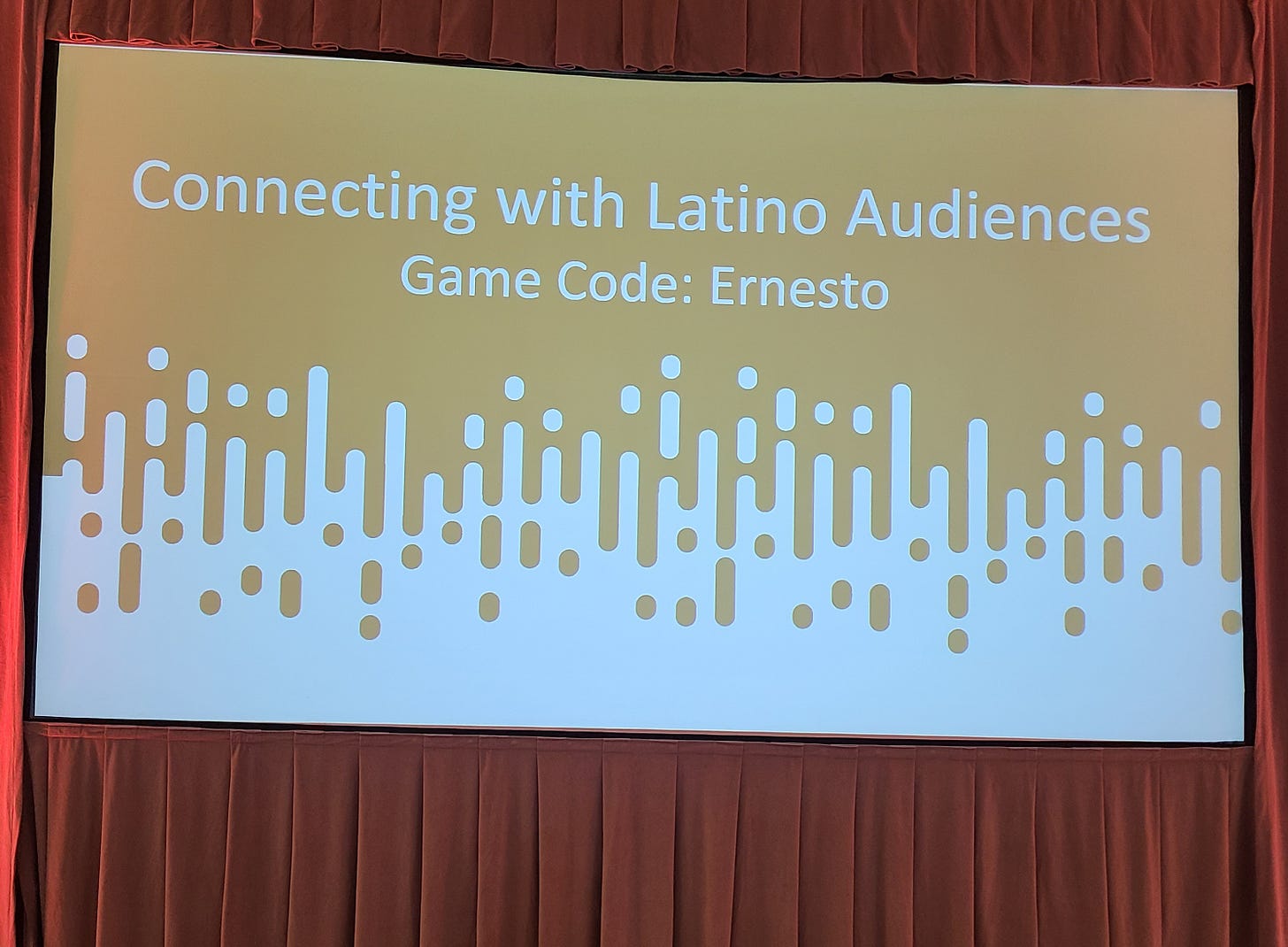Inviting Latine Audiences: Takeaways from PRPD
Yesterday at the 2023 Public Radio Content Conference, engaging Latino and bilingual listeners took the main stage. In a buzzing hotel ballroom, ideas, research and strategies to better serve this audience had people talking. 💬
As I mentioned on LinkedIn, I’ve done many conference sessions about DEI, diversity and Latine audiences over my career. 🗺️ They have been in various sizes of rooms, in concurrent tracks against very attractive panels, and in simple as well as complicated settings. For those working to diversify public media, this was special. When reaching Latino/a listeners is the main event — in a conference hotel’s main ballroom and the focal point of conversation and attention — you marvel. We don’t get these moments often. 🍻
Hosted by the Public Media Content Collective, formerly the Public Radio Program Directors Association, the conference drew program directors and decision-makers from across the public radio system. They intently absorbed data and insights from a panel that included me, NPR’s Lauren Gonzalez and Edison Research’s Gabriel Soto… and attendees brought many of their own ideas, too.
It was evident that reaching Latinx and bilingual audiences is an idea whose time has come. Sitting on the stage, I can say that this is discussion our colleagues in public media are hungry for. 🍽️
As the Latine population continues to grow in the United States, media organizations are focusing more on how to best engage with this large and influential demographic. Throughout the conference, program leaders from public media discussed strategies for appealing to racially diverse and younger audiences. 🏔️ Even where there was no strategy yet, there was a desire for one.
Their discussion yielded several key takeaways:
Latinx listeners may have many nuances between different cultures and backgrounds, but we’re not from outer space, and your station can connect with us.
The Latine community is remarkably diverse, encompassing people from over 20 Spanish-speaking nations and cultures across Latin America. As presenter Gabriel Soto noted, 63.7 million Latinos currently live in the U.S., representing over 19 percent of the total population. Station leaders should avoid treating Hispanics as a monolithic block, and instead understand nuances between different cultural backgrounds. For example, recent studies found media usage differences between U.S.-born and foreign-born Latinos.
However, as Lauren Gonzalez emphasized, Latino/a audiences have much in common with all Americans. She urged organizations to tap into shared experiences to build trust with listeners. 🗣️ Gonzalez offered that deeply listening to people's needs may prove revelatory in serving Latine communities authentically. Though diversity is often acknowledged, Latinos still seek the same bonds and understanding as other groups. By recognizing shared values instead of viewing these audiences as outsiders, public media outlets can strengthen engagement.
Latinos over-index on digital and social media consumption — remember that, but don’t use it as a reason to avoid terrestrial broadcast innovation.
Latino/as tend to be earlier adopters of digital and social platforms compared to the overall U.S. population. 🛰️ For instance, Latinos spend an extra hour daily consuming audio vs. the general market. Streaming sites like YouTube are hugely popular for music and podcasts, while emerging social apps like TikTok and Discord over-index with Latinx users. This presents opportunities for multimedia and culturally relevant content.
Adding to that, a new Nielsen study points out Hispanic audiences consume live and time-shifted broadcast content 22 percent less than all other demographics. Trust, the organization cites, is key to engagement. An open question at many conference sessions was how to win back people’s attention and trust. Latinx listeners are no exception.
Bilingual and culturally relevant content is important, but it needs to feel natural, not forced or performative. Intergenerational conversations can be a good way to incorporate bilingual programming.
Programming interspersing English and Spanish or Spanish-only needs to feel natural, not forced. Lauren Gonzalez advised against performative Spanish, and instead recommended purposeful inclusion where appropriate. 🛎️ Intergenerational conversations can allow fluid switching between languages, mimicking how many bicultural Latino families speak, particularly with older Hispanics.
I pointed out that we are currently in a pivotal moment for bilingual programming. The desire for easy solutions around Spanish-language content is understandable. However, the reality is complex.
I liken the present journey to the immigrant experience. For many Americans, immigrant relatives faced circuitous paths while adjusting to a new culture. It was often messy, confusing and frustrating. But perseverance through the uncertainty led to beautiful new chapters. Similarly, public media is organically developing its "bilingual sound" in real time. The audience appetite for inclusion is driving the effort. But finding the right voice will take nurturing. Some early attempts may feel awkward before they feel seamless. Yet embracing this fluid period with patience, care and community input will lead to meaningful results.
Use fear to see opportunity.
When Gabriel Soto mentioned this, you could see heads virtually explode, because it’s so true. 🎚️
The fear of not fully understanding a complex and nuanced Latino audience can inspire innovative approaches to listening and research. 🖨️ Deeply engaging with Latino communities to grasp their diversity of perspectives and needs can unlock creative ideas.
The fear of linguistic or cultural missteps in Spanish programming can motivate establishing authentic partnerships. 🎟️ Collaborating with Latinx creatives, community advisors and intergenerational families can lead to more natural bilingual content.
The fear of losing audience share by not reflecting America's demographics can drive pioneering distribution strategies. 🗂️ Experimenting with social platforms and multimedia formats favored by younger Latinos can position public media organizations for the future.
The fear of lacking sufficient staff diversity can encourage new mentorship programs and retention tactics. 🛫 Proactively fostering Latine leadership talent and growth initiatives can differentiate a station brand.
The fear of misjudging audience data or reception can prompt iterative testing and feedback channels. 🌡️ Small pilot initiatives with built-in impact measurement and community response tools can reduce risk.
Essentially, being open about fears and uncertainties can catalyze the right conversations and willingness to try new approaches. 🗃️ This vulnerability is key to innovating successfully with underserved audiences. Leaning into fears meaningfully can bring exciting opportunities into focus.
The insights shared in this discussion make a compelling case for why public media organizations are making and should make Latinx audiences a priority. With strategic, nuanced outreach across digital platforms, thoughtful bilingual content, and a commitment to representation, public media outlets can build deeper engagement and loyalty with this large population of diverse listeners and viewers. By taking the right small steps today, guided by data and community voices, public media outlets can stay relevant and better serve everyone in the future. 🟢
Cafecito: stories to discuss ☕
NAHJ, the Maynard Institute and a coalition of groups have called for the Press Forward initiative to support diverse media. ✔️
When a couple bought a Napa station in 2017 and changed the format to all-Spanish, the move garnered protest. 🤯 The Press Democrat offers an update on the now-successful outlet.
NBC shares a story on the "no sabo" social media trend, which highlights Hispanics who can’t speak Spanish. 🙅♂️ The trend opens up wider discussions about what it means to be Latino/a.
A Mexico City radio station is innovating content aimed squarely at a digital audience. 🎤 More at Nieman Lab.
The Fresno Bee shares some learnings for serving Latinx readers. 🎸 Better News has the details.
El radar: try this 📡
Ask if bilingual ads hit. Marketplace covered the rise of ‘Spanglish’ in advertising. 🗒️ Could your public media organization explore the emergence of bilingual advertising and how it connects with local communities that may have grown up bilingual and multicultural?
See how Narcan education is occurring. Fentanyl overdose deaths among Latinos in Los Angeles County jumped 721 percent from 2016 to 2021, reflecting the devastating yet hard to quantify impact of the opioid epidemic on local immigrant communities. 👩⚕️ LAist just reported on an innovative program provides Narcan training and opioid risk education to Spanish-speaking consulates, targeting outreach to vulnerable populations. Is this happening near you?
Spotlight Latine voter feelings about both parties. There are sure to be many Latino/a voter pieces in 2024 (how to do better Hispanic voter coverage was shared in OIGO before). 🗳️ WUNC did a program on the challenges facing both major parties. Pop this on your to-do list.
Explore Latinx geographic changes. Driving north on Virginia's Eastern Shore reveals a subtle cultural fusion, from the radio to small businesses. 🏢 RVA Magazine examined how traditions blend in transitory moments, and this seems like a story rich for localization.
The next OIGO is here Oct. 5. Documenting your real-world examples and advice can accelerate system-wide adoption of ideas that demonstrate diverse impact. Let's elevate local innovations to advance public media's mission of serving and reflecting all Americans. Please share your public service success stories. Hit reply and let me know!
Finally, I have professional news coming next week. 🥳 Check me out on LinkedIn or Twitter, if you’re curious.
🥤 You can buy me a coffee if you’d like to support the newsletter.








